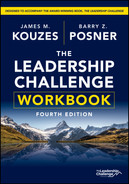
Enable Others to Act
LEADERS KNOW that they can't make extraordinary things happen all by themselves. Achieving greatness requires a team effort, so leaders invest in building trust and in developing enduring relationships. They know that as organizations become increasingly diverse and dispersed, physically and globally, collaborative skills are more important than ever to navigating conflicting interests and natural tensions.
Mutual respect is what sustains extraordinary group efforts. Leaders build the skills and abilities of their constituents to deliver on commitments. They create a climate where people feel in control of their own lives.
To Enable Others to Act, you foster collaboration by building trust and facilitating relationships, and you strengthen others by increasing self‐determination and developing competence.
Here are examples from personal‐best cases we've collected of how leaders Enable Others to Act:
- The first order of business for a program manager in a multinational technology firm was to learn how to trust her employees. She wanted to develop a cohesive and collaborative team, with trust as the framework. She began by creating an environment in which people felt comfortable asking questions and making mistakes. She talked with each person about mutual expectations and progress on key objectives, helped them develop working relationships with others outside of their department, and gave them ownership of and responsibility for their projects, along with the information, support, and training they would need. She then made sure to give them recognition for their work.
- The principal of an underperforming school needed to make some radical changes in the curriculum in order to improve student achievement. As part of this major project, he created an Instructional Leadership Team made up of respected teacher‐leaders and gave them the discretion to determine curriculum. To show support for this team, at curriculum meetings only teachers sit at the discussion table. Administrators sit in chairs around the team to signal that they are there to support, and not to decide.
- The chief information officer of a global technical, professional, and construction services company was charged with rolling out a worldwide safety and leadership program to the IT organization—more than 800 people. Rather than leading the training sessions herself, or having someone in the training department do it, she asked everyone in the first two layers of the IT organization to lead at least one workshop. Everyone agreed that they got as much out of facilitating a workshop as any of the participants.
- When the incoming commander of a U.S. Navy ship took over, morale was terrible and performance was the worst in the service. He knew he had to do something immediately to turn the situation around. He decided to spend one hour with each of the 310 sailors just talking about themselves and their needs. In the process of listening and paying attention, he not only built rapport and understanding, but he also gathered ideas about how to improve the ship that, when implemented, saved the Navy millions of dollars.
- A manager inherited a very small staff when she took over an Australian program that helped local leaders set up, manage, fund, and lead successful social ventures. One of her staff members was very shy and had a real fear of speaking in public. He was happy to distribute the name badges at events, but that was it. He even feigned illness to get out of speaking engagements. The manager asked him, “How can we get you speaking in public?” Then she edged him toward it very gently. He gave a presentation to a small group, then to a slightly larger group, and then to another slightly larger group. In under a year, he stood on a platform presenting business awards to a large crowd. Afterward, he said, “Oh, my gosh, I can't believe I did it!”
- An American financial services executive was appointed the managing director of one of its foreign offices. Because he was an outsider, he was viewed with skepticism. Rather than jump in with all kinds of changes, his first acts were to get to know people—who they were, what motivated them, what things they liked to do, and what they thought they could accomplish collectively. These early acts of relying on “local experts” quickly earned him respect and enabled all of them to significantly improve services.
OBJECTIVES
As a result of completing the worksheets in this chapter, you'll be better able to:
- Build supportive relationships with your project team members
- Develop the competence and confidence of team members
- Develop cooperative working relationships among team members
- Connect team members to the people they need to get extraordinary things done
